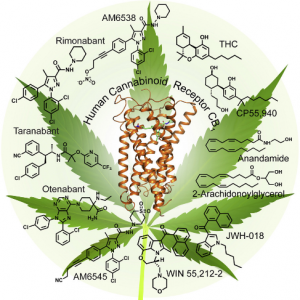Function of the Endocannabinoid System
The endocannabinoid system (ECS) was a mysterious being for quite some time, considering its recent discovery in only 1988. Although it is still in its infancy from a research standpoint, it is now known to be a major regulator with one primary goal: maintaining homeostasis. Many researchers consider the ECS to be the most important physiological system in establishing and maintaining human health. This is due in large part to the extensive network of cannabinoid receptors (CBR) located throughout the central nervous system (CNS), from neurons to immune cells to glands to organs. The ECS has been shown to be involved in many imperative processes:
- Appetite and digestion

Neuroprotective effects of CB1R activation through GSK-3 inhibition (Snitow, Bhansali, and Klein, 2021). - Immune function and inflammation
- Mood
- Sleep
- Reproduction/fertility
- Learning and memory
- Pain
- Motor control
Due to the wide range of ECS functions and receptor activation, the use of endocannabinoids, specifically cannabis, have been implicated in the treatment of a variety of diseases. Some of these diseases include multiple sclerosis (MS), Alzheimer’s disease (AD), and Huntington’s disease (HD). This is due to the fact that activation of CB1R by endocannabinoids have been shown to promote neuroprotective effects (Kendall and Yudowski, 2017). It has been found that administration of THC increases phosphorylation of Akt in the hippocampus, striatum, and cerebellum, mediated by CB1R (as phosphorylation was blocked with CB1R antagonist). Along with this, THC was also shown to increase inhibitory phosphorylation of GSK3ß (Ozaita, Puighermanal, and Maldonado, 2007). GSK3ß inhibition is involved in the activation of Wnt signaling and its target genes, one of these genes being BDNF which is heavily involved in neuroprotection. Inhibition of GSK3ß is also involved cell proliferation and survival (Snitow, Bhansali, and Klein, 2021). The molecular underlying of CB1R activation through THC has shown to provide neuroprotective effects in battling neurodegenerative disease. Along with maintaining homeostasis, the ECS may be necessary for much more.
How does the ECS Work?
The ECS utilizes endogenous cannabinoids (endocannabinoids), cannabinoid receptors, and enzymes to break down endocannabinoids. The endocannabinoids, 2-AG and anandamide (AEA), are retrograde ‘neurotransmitters,’ meaning they work from post to pre-synapse, rather than pre to post-synapse. Also, rather than being synthesized prior to use and stored in vesicles such as traditional neurotransmitters, endocannabinoids are rapidly synthesized upon demand. They are then released into extracellular space where they bind to a CBR on the pre-synaptic terminal (Lu and Mackie, 2016). There are two main types of cannabinoid receptors:

- Cannabinoid Receptor 1 (CBR1) – a G-protein coupled receptor (Gi/o) abundant in neurons of the CNS (cortex, basal ganglia, cerebellum, and hippocampus)
- Cannabinoid Receptor 2 (CBR2) – a G-protein coupled receptor (Gi/o) abundant in the immune system and associated structures
Some researchers hypothesize that there may be a third cannabinoid receptor as well. Although, these are likely widespread with each receptor having a specific function (Sallaberry and Astern, 2018). Lastly, the ECS has specific enzymes used to break down the endocannabinoids. AEA is primarily degraded by the enzyme fatty acid amino hydrolase (FAAH). A second degradation process may be through oxidation via cyclooxygenase-2 (COX-2) to form prostamides. 2-AG may be degraded by three hydrolytic enzymes: monoacylglycerol lipase (MGL) and alpha/beta domain hydrolases 6 and 12 (ABHD6 and 12). It may also be oxidized by COX-2, or under rare conditions, hydrolyzed by FAAH. MGL is the primary degrading enzyme for 2-AG (Lu and Mackie, 2017).
The ECS and Cannabis Use
The ECS interacts with both delta-9-tetrahydracannabinol (THC) and cannabidiol (CBD) in the marijuana plant, but in differing ways. THC is most similar to AEA, as they are both low-efficacy agonists of the CB1R (Lu and Mackie, 2017). Although, THC produces a high while AEA does not. This is due to the enzyme, FAAH, which breaks down AEA but is not able to break down THC. Therefore, THC acts as competitive inhibitor for the body’s natural endocannabinoids which produces a dramatic effect due to its psychoactive properties. Although, AEA has been shown to produce calming effects. Researchers believe CBD works through inhibiting the FAAH enzyme from breaking down AEA to produce a calm sensation without psychoactive side effects.
References
Kendall, D. A., & Yudowski, G. A. (2017). Cannabinoid receptors in the central nervous system: Their signaling and roles in disease. Frontiers in Cellular Neuroscience, 10. https://doi.org/10.3389/fncel.2016.00294
Lu, H.-C., & Mackie, K. (2016). An introduction to the endogenous cannabinoid system. Biological Psychiatry, 79(7), 516–525. https://doi.org/10.1016/j.biopsych.2015.07.028
Ozaita, A., Puighermanal, E., & Maldonado, R. (2007). Regulation of PI3K/AKT/GSK-3 pathway by cannabinoids in the brain. Journal of Neurochemistry, 102(4), 1105–1114. https://doi.org/10.1111/j.1471-4159.2007.04642.x
Sallaberry, C., & Astern, L. (2018). The Endocannabinoid System, Our Universal Regulator. https://doi.org/10.22186/jyi.34.5.48-55
Snitow, M. E., Bhansali, R. S., & Klein, P. S. (2021). Lithium and therapeutic targeting of GSK-3. Cells, 10(2), 255. https://doi.org/10.3390/cells10020255
